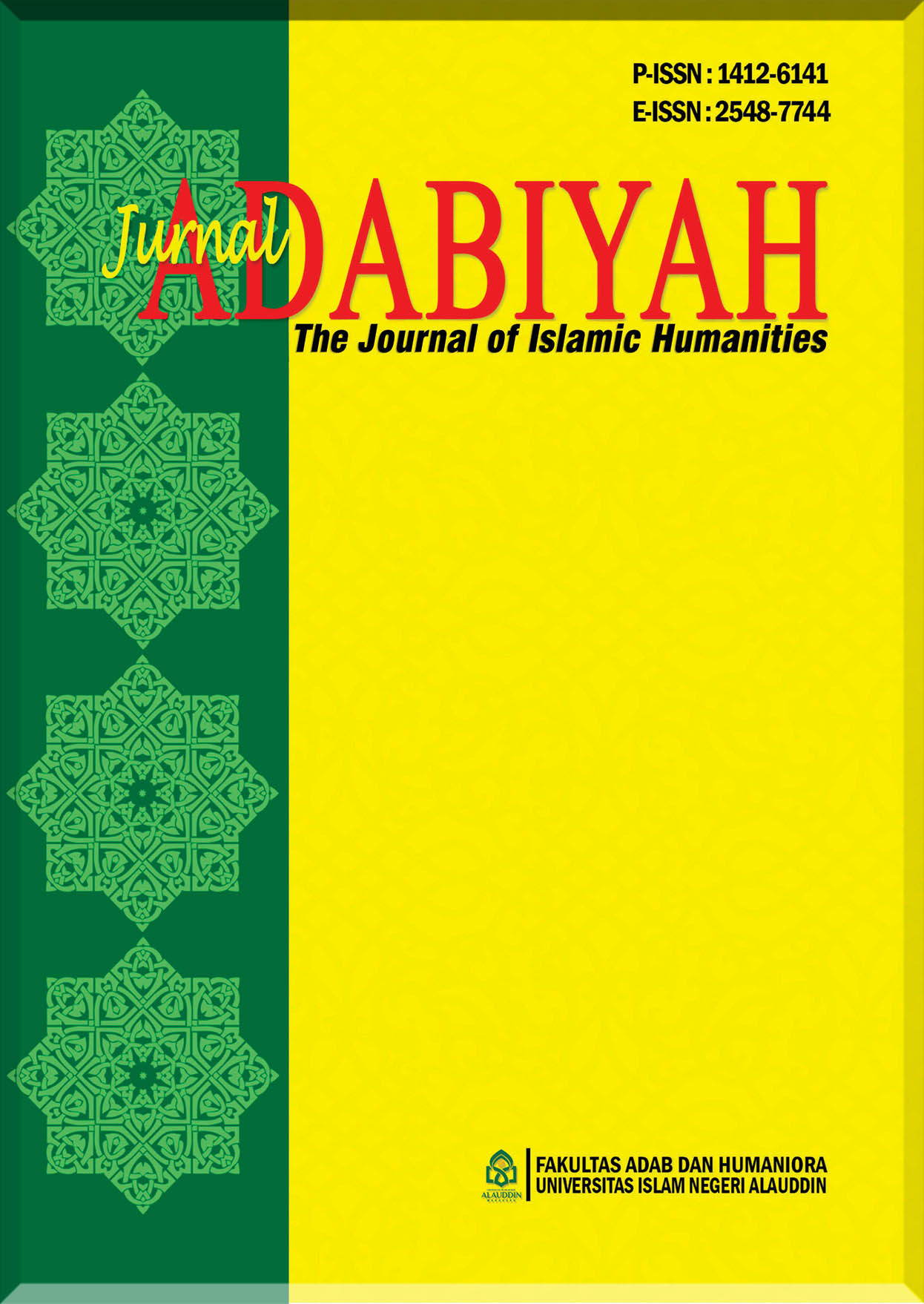Incorporating Popular Culture Elements into Hanan Attaki’s Dakwah
DOI:
https://doi.org/10.24252/jad.v25i2a6Keywords:
Popular Culture, Islamic Preaching, Digital Dakwah, Ustaz Hanan Attaki, Youth AudienceAbstract
The current research aims at exploring the use of popular culture in the preaching (or Dakwah, in popular Indonesian term) delivered by Ustadz Hanan Attaki. As one of the most popular Islamic preachers in Indonesia, Ustadz Hanan Attaki applies the elements of popular culture, such as slang languages, English terms, music, and youth fashion, to deliver the Islamic teaching. The ways of applying the preaching with popular culture, is considered as relevant and appealing for the youths. Through the qualitative approach, the current research analyzes Ustadz Hanan Attaki’s preaching through the Fairclough’s critical discourse analysis, to get the ideas of how the popular culture is integrated into his preaching. The result shows that the use of popular culture does not only increase the preaching, but it also strengthens the audience’ understanding of Islamic values through the terms that are familiar to the young people. The strategy also attracts the emotional bond between the preacher and the audience so that the religious messages is accepted and comprehended. The reference of popular culture is sometimes also problematic as it is basically in the different discourse. The current research concluded that the integration of popular culture in religious preaching is effective strategy for a preaching which is contextual, although it is necessary to be careful so that it does not blur or make the religious teaching biased.
الملخص
يهدف البحث الحالي إلى استكشاف استخدام الثقافة الشعبية في الوعظ الذي ألقاه الأستاذ حنان أتكي. باعتباره أحد الدعاة الإسلاميين الأكثر شعبية في إندونيسيا، يطبق الأستاذ حنان أتاكي عناصر الثقافة الشعبية، مثل اللغات العامية والمصطلحات الإنجليزية والموسيقى وأزياء الشباب، لتوصيل التعاليم الإسلامية. تعتبر طرق تطبيق الوعظ مع الثقافة الشعبية ذات صلة وجذابة للشباب. ومن خلال المنهج النوعي، يحلل البحث الحالي وعظ الأستاذ حنان أتاكي من خلال تحليل الخطاب النقدي لفيركلاف، للحصول على أفكار حول كيفية دمج الثقافة الشعبية في وعظه. وتظهر النتيجة أن استخدام الثقافة الشعبية لا يؤدي إلى زيادة الوعظ فحسب، بل يعزز أيضًا فهم الجمهور للقيم الإسلامية من خلال المصطلحات المألوفة لدى الشباب. كما تعمل الاستراتيجية على جذب الرابط العاطفي بين الداعية والجمهور بحيث يتم قبول الرسائل الدينية وفهمها. في بعض الأحيان تكون الإشارة إلى الثقافة الشعبية مشكلة أيضًا لأنها موجودة بشكل أساسي في الخطاب المختلف. وخلصت الدراسة الحالية إلى أن دمج الثقافة الشعبية في الوعظ الديني هو استراتيجية فعالة للوعظ السياقي، على الرغم من أنه من الضروري توخي الحذر حتى لا يؤدي إلى طمس أو جعل التعاليم الدينية متحيزة
Abstrak
Penelitian kali ini bertujuan untuk mengeksplorasi pemanfaatan budaya populer dalam dakwah yang disampaikan oleh Ustadz Hanan Attaki. Sebagai salah satu pendakwah Islam terpopuler di Indonesia, Ustadz Hanan Attaki menerapkan unsur-unsur budaya populer, seperti bahasa gaul, istilah Inggris, musik, dan fashion anak muda, dalam menyampaikan ajaran Islam. Penerapan dakwah dengan budaya populer, ini sangat relevan dan menarik bagi generasi muda. Dengan pendekatan kualitatif, penelitian kali ini menganalisis dakwah Ustadz Hanan Attaki melalui analisis wacana kritis Fairclough, untuk mendapatkan gambaran bagaimana budaya populer diintegrasikan ke dalam dakwahnya. Hasil penelitian menunjukkan bahwa penggunaan budaya populer tidak hanya meningkatkan dakwah, tetapi juga memperkuat pemahaman jamaah terhadap nilai-nilai Islam melalui istilah-istilah yang akrab di telinga generasi muda. Strategi tersebut juga menarik ikatan emosional antara penceramah dan pendengarnya sehingga pesan-pesan keagamaan dapat diterima dan dipahami. Referensi budaya populer terkadang juga bermasalah karena pada dasarnya keduanya berbeda wacana. Penelitian yang dilakukan saat ini menyimpulkan bahwa integrasi budaya populer dalam dakwah keagamaan merupakan strategi yang efektif untuk dakwah yang bersifat kontekstual, namun perlu kehati-hatian agar tidak mengaburkan atau menjadikan ajaran agama menjadi bias.
Downloads
References
Agustin, N., Prasetyo, B., Hasanah, NA., Al Bustomi, AY., Aziz, MA., (2023). Utilization of tik-tok as a da’wah media of kadam sidik in the contemporary era. doi: 10.20414/jurkom.v15i2.8571
Balcerowska, J. M., & Brailovskaia, J. (2023). Psychopathological Symptoms and Social Networking Sites Addiction in Poland and Germany: The Role of Fear of Missing Out and Preference for Online Social Interaction. https://doi.org/10.2139/ssrn.4600002
Campbell, H. A., & Tsuria, R. (2021). Digital Religion: Understanding Religious Practice in Digital Media. Routledge.
Cherewick, M., Lama, R., Roshan, P., Dukpa, C., Mukhia, D., Giri, P., & Matergia, M. (2024). Social support and self-efficacy during early adolescence: Dual impact of protective and promotive links to mental health and wellbeing. PLOS Global Public Health, 4(12), e0003904. https://doi.org/10.1371/journal.pgph.0003904
Ernawati, A. (2022). The struggle between romance and faith: study of the da'wah message in the film "ajari aku islam". Profetik: Jurnal Komunikasi, doi: 10.14421/pjk.v15i1.2411
Fairclough, N. (2010). Critical Discourse Analysis: The Critical Study of Language (2nd ed.). Routledge.
Fairclough, N. (1989). Language and Power. United Kingdom: Longman Group UK Ltd
Farabi, A. (2024). Initiating The Future Of Da’wah (Study Of Manara Studios’ Innovative Strategy In Reaching Out Alpha Generation). Riwayat. doi: 10.24815/jr.v7i2.38843
Husein, F., Slama, M. 2018. Online piety and its discontent: revisiting Islamic anxieties on Indonesian social media. Indonesia and the Malay World. Vol. 46, No. 134, 80–93 https://doi.org/10.1080/13639811.2018.1415056
Kanafi, I., Dahri, H., Susminingsih, S., & Bakhri, S. (2021, May 20). The contribution of Ahlussunnah Waljamaah’s theology in establishing moderate Islam in Indonesia. https://doi.org/10.4102/hts.v77i4.6437
Mamalipurath, J M. (2022, October 1). When Islam goes to TED: features of a postsecular storytelling on Islam in new media. https://doi.org/10.1007/s11562-022-00496-4
Mutia, T. (2022). Da’wahtainment: The Creativity of Muslim Creators in Da'wah Communication on Social Media. Jurnal Dakwah Risalah, doi: 10.24014/jdr.v32i2.15536
Muttaqin, A. 2020. Women’s Identity in the Digital Islam Age: Social Media, New Religious Authority, and Gender Bias. Qijis Journal. 8(2). DOI : 10.21043/qijis.v8i2.7095
Nafiah, R. K., & Izzaty, R. E. (2024). Parental support in nurturing self-efficacy: understanding youth expectations during early adolescence. JPPI (Jurnal Penelitian Pendidikan Indonesia), 10(2), 161. https://doi.org/10.29210/020243864
Nieuwkerk, C V., Levine, M., & Stokes, M. (2016, December 31). Introduction: Islam and Popular Culture. University of Texas Press eBooks, 1-20. https://doi.org/10.7560/308875-001
Nurcholis, A., Hidayatullah, SI., Izzatul, Laila. (2019). Inspirational da’wah for millennial generation: study at iain tulungagung. doi: 10.14421/JMD.2019.52-03
Oostindie, G., & Roitman, J V. (2014, January 16). In Search of Middle Indonesia. https://doi.org/10.1163/9789004263437
Putri, C. A., & Sa’id, M. (2024). The Effect of FoMO and Social Media Addiction on Phubbing Behavior in Adolescent K-Pop Fans. Nusantara Journal of Behavioral and Social Science, 3(4), 169–178. https://doi.org/10.47679/njbss.202464
Rahayu, M. (2020). The discourse of radicalism and family roles in standing against radicalism represented in Garin Nugroho’s film “Mata Tertutup”. Jurnal Ilmiah Islam Futura, 20(01), 105-119.
Rahayu, M., & Mediyansyah, M. (2020, September). Terrorism in Popular Media: How Hollywood Represent Muslim Terrorist. In Proceedings of the The 2nd ICS Universitas Mataram International Conference: Countering Radicalism & Terrorism in the Digital Era-Reshaping a Global Peace Community.
Rahayu, M., Sahiruddin, S., Risdianto, F., Rusdiah, R., Rabiah, S, & Taufiqurrahman,R. (2023). “The Sum of All Fears” from novel to film: shifting the discourse of terrorism. World Journal of English Language, 13:7, 186-193.
Rahayu, M., Santi, VN., and Munjiah, M (2024) The integration of popular culture in Islamic dakwah for gen Z: Case study of Ustadz Hanan Attaki and Ustadzah Oki Setiana Dewi’ dakwah. Research Report. LP2M UIN Malang, Malang.
Rodiyah, M., Abdurahman, D., & Dermawan, A. (2022, March 6). The Muqtadhal Haal Da’wah of K.H. Dalhar and Its Relevance in Modern Society. https://doi.org/10.5296/ijssr.v10i1.19400
Rohmatulloh, DM., Achfandhy, M., Patmaningsih, A. (2023). The encounter of da’wah digitalization with urban Muslim culture. doi: 10.32332/akademika.v28i1.7751
Saputra, E. (2022). Ngaji asik sambil ngopi: strategi branding komunitas “teras dakwah” di Yogyakarta, Indonesia (learning islam while enjoying coffee: a branding strategy of “teras dakwah" community in yogyakarta, indonesia). Jurnal Sosiologi Reflektif, doi: 10.14421/jsr.v16i2.2313
Saputra, E. (2022, July 4). Marketing Da’wah through New Media at the "Teras Dakwah” (Da’wah Terrace) Yogyakarta, Indonesia. https://doi.org/10.24014/jdr.v33i1.18159
Satria, B., Jumiyati, Romadi, P., and Alwi, R., “Youth, Da'wah and Tik Tok: A Case Study of Husain Basyaiban,” JIM – Journal International Multidiciplinary 1, no. 2 (2023), https://doi.org/10.58794/jim.v1i2.496.
Slama, M. 2018. Practising Islam through social media in Indonesia Martin Slama, Indonesia and the Malay World, 46:134, 1-4, DOI: 10.1080/13639811.2018.1416798
Slama, Martin. 2017. A subtle economy of time: Social media and the transformation of Indonesia’s Islamic preacher economy: Social Media and Indonesia’s Islamic Preacher Economy. Economic Anthropology 4: 94–106
Sonjaya, R., Sari, IP., Dulwahab, E. (2024). Patterns of Dakwah Communication Among Youth Through Mamaos Cianjuran Culture. Ilmu Dakwah, doi: 10.15575/idajhs.v17i2.32723
Umam, KS. (2022). A new Muslim youth culture. doi: 10.4324/9780429265860-38
Vemuri, V. P. (2024). Perspective Chapter: The Impact of Social Media on the Fear of Missing Out (FOMO) among Teenagers Aged between 18 and 25. https://doi.org/10.5772/intechopen.1006510
Wu, W., Zhang, J., & Jo, N. (2025). Fear of Missing out and Online Social Anxiety in University Students: Mediation by Irrational Procrastination and Media Multitasking. Behavioral Sciences, 15(1), 84. https://doi.org/10.3390/bs15010084
Downloads
Published
How to Cite
Issue
Section
License
Copyright (c) 2025 Mundi Rahayu, Vita Nur Santi, Ma'rifatul Munjiah, Abdul Muntaqim Al Anshory

This work is licensed under a Creative Commons Attribution-NonCommercial-ShareAlike 4.0 International License.
COPYRIGHT AND LICENSE STATEMENT
COPYRIGHT
Jurnal Adabiyah is published under the terms of the Creative Commons Attribution license. Authors hold the copyright and retain publishing rights without restriction to their work. Users may read, download, copy, distribute, and print the work in any medium, provided the original work is properly cited.
LICENSE TO PUBLISH
1. License
The use of the article will be governed by the Creative Commons Attribution license as currently displayed on http://creativecommons.org/licenses/by/4.0.
2. Author’s Warranties
The author warrants that the article is original, written by stated author/s, has not been published before, contains no unlawful statements, does not infringe the rights of others, is subject to copyright that is vested exclusively in the author and free of any third party rights, and that any necessary written permissions to quote from other sources have been obtained by the author(s).
3. User Rights
Under the Creative Commons Attribution license, the users are free to download, reuse, reprint, modify, distribute and/or copy the content for any purpose, even commercially, as long as the original authors and source are cited. No permission is required from the authors or the publishers.
4. Co-Authorship
If the article was prepared jointly with other authors, the corresponding author warrants that he/she has been authorized by all co-authors, and agrees to inform his/her co-authors of the terms of this statement.
5. Miscellaneous
Jurnal Adabiyah may conform the article to a style of punctuation, spelling, capitalization, and usage that it deems appropriate. The author acknowledges that the article may be published so that it will be publicly accessible and such access will be free of charge for the readers.




